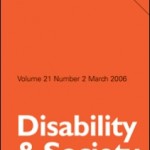Following on from yesterday’s MRL lecture, I was fortunate to talk with Prof. Dame Wendy Hall about my research and a short paper I’ve written on ‘Aversive Disablism and the Internet’, borne out of Blogging Against Disablism Day. This paper has been accepted for the 1st Symposium for Humanities and Technology Interface 2009, at the University of Southampton in July. The Symposium looks to explore many of the themes of Web Science advocated by Dame Wendy and other Soton and MIT colleagues, alongside more diverse interdisciplinary projects.
Interface requires that all delegates present either a Lightning Talk of 2 minutes, or a poster presentation. I’ve pulled on my size 6.5 Lightning Boots, and opted for the former presentation style – and in conversation with Dame Wendy had a chance to rehearse my pitch on aversive disablism and it’s relevance for advancing debate and action on digital inclusion. Professor Hall immediately related this notion back to W3C web standards and asked my view on this – was I stating that (dis)ablism occurred at this level? This turned the conversation to hierarchies of impairment.
Within accessibility practice (as in many other spheres) research and resources frequently prioritise certain communities and their requirements above others for a nexus of reasons. In brief terms, hierarchical views of disability and impairment have been researched since the 1970s, but in 2003, Deal published Disabled people’s attitudes toward other impairment groups: a hierarchy of impairments (Disability & Society,18:7,897-910) to explore potential inter-group discrimination amongst disabled people. Deal’s thorough review of the literature relating hierarchic understandings of impairment by both disabled and non-disabled people is essential reading. Deal concludes with a call for research in this area, and notes that:
…it is important that, whilst disabled people fight a common cause in seeking equality within society and the removal of discriminatory practices, strategies for attitude change are targeted in a manner that makes them most effective. This may include focusing attention on impairment groups that face the most discrimination in society (i.e. those ranked lowest in the hierarchy of impairments), rather than viewing disabled people as a homogenous group.
Deal’s later PhD research explores the nuances of this hierarchy. His thesis Attitudes of Disabled People Toward Other Disabled People and Impairment Groups from 2006 can be found hosted at the Enham Research pages.
When relating these sociological frameworks to the internet, there is no doubt that, in pro-disabled accessibility discourse, certain groups are privileged above others. Whilst there is increasing sensitivity to this in Computer Science, with developers and researchers working to close the distance, this reasons for this divide are under-theorised within ICT discourse.
Much accessibility research focuses strongly on achieving accessibility for people with mobility, sensory and some text impairments – this is clearly important work, however, it does not represent the totality of necessary accessible practice. For example, when Brian Kelly and others cited limits to the W3Cs Web Accessibility Initiative in their paper 2007 Accessibility 2.0: People, policies and processes they upheld Joe Clarke’s observation that the WACG development process lacked adequate provision for users with cognitive disabilities and learning difficulties. Kelly et al also cited Lisa Seeman’s formal objection to WCAG 2.0, requesting that implicit claims that the guidelines did cover cognitive disabilities be omitted from the guidelines’ abstract altogether. I would argue that this is one example of an occassion where cognitive and learning disablities have been afforded lower status in development discourse history and suffered aversive disablist outcomes as a result.
Clearly, accessible practise contends with the grey areas of potentially conflicting subjectivities. But viewed in light of Deal’s call to arms; adopting theory and strategies emergent from disability studies in the heart of mainstream internet practice would, I feel, create stronger debate pushing foward positive outcomes for all disabled people. Is this a matter for a ‘Disability Web Science’?



